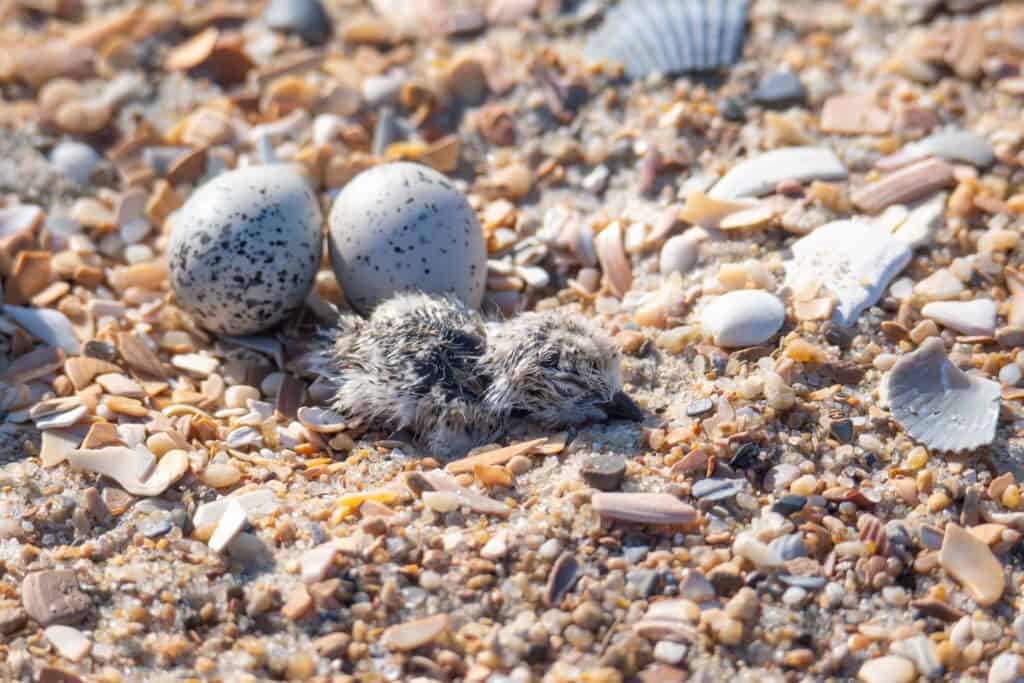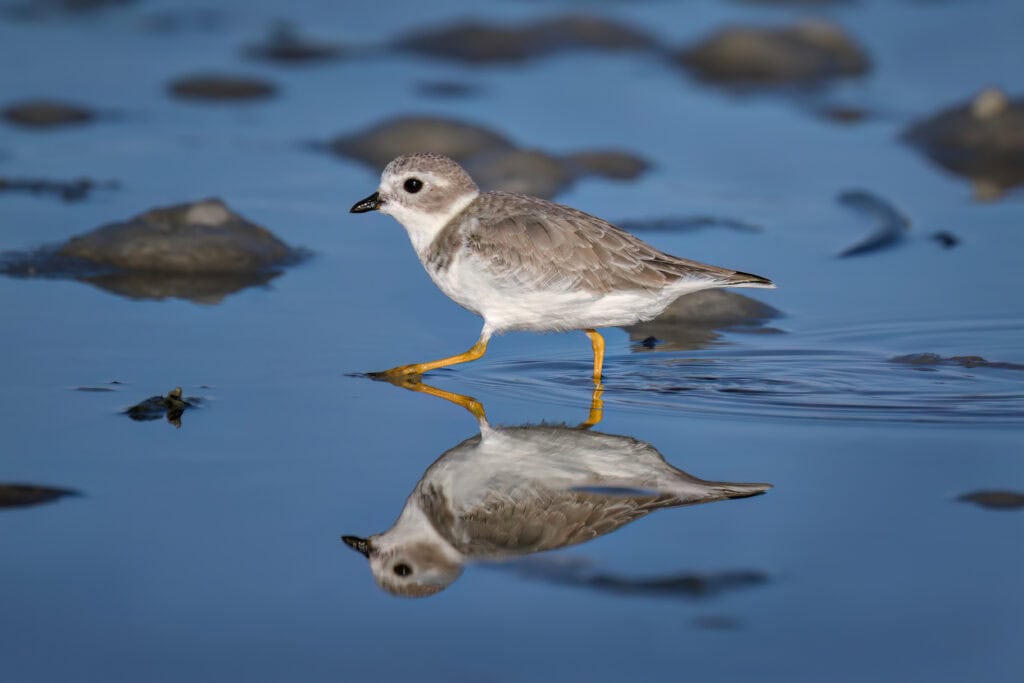Just steps from the New York City subway, 32 piping plovers and their young scuttle across 20 blocks of beach on the Rockaway Peninsula. They blend in with the sand as they run to and from the tides to forage, the hatchlings the size of golf balls, ducking dive-bombing terns and dodging hungry ghost crabs.
You can catch a glimpse of the birds if you’re lucky—or if you have binoculars, as the beach where they nest is largely closed to the public during the summer nesting season.
While plover populations have grown in the region since the species was granted special protections through the Endangered Species Act in 1985, some community members are left wondering why birds have more rights to enjoy the beach than they do. In response, wildlife managers are trying to create a solution that will give more access to community members while still protecting plovers and complying with federal law.
The New York City Parks Department manages about seven miles of beaches in the Rockaways, closing a little more than a mile of beach during the summer nesting season. Starting in 2023, the agency piloted a dynamic management approach that allows walking or running along the water depending on the sensitivity of plover nests.

There are two closures for nesting birds: one stretching nearly 20 blocks and another smaller closure. The majority of the remaining beach managed by NYC Parks is open for full recreational use.
“We want to keep our conservation goals intact while also allowing for shoreline access to beachgoers,” said Amber Krauss, the wildlife program coordinator at the agency’s parks wildlife unit.

Probing plovers
Piping plovers (Charadrius melodus), which are listed as endangered in the state of New York and threatened under the U.S. Endangered Species Act, were first recorded nesting at Rockaway Beach in 1996. After that, they kept coming back. Plovers, like New Yorkers, are loyal to the neighborhood they grew up in, laying their own nests on the beaches where they hatched.
“After that first bird was found, the NYC Parks began protecting a small footprint of the beach for the protection of the nesting birds,” Krauss said. Over the years, the number of birds has generally increased, reaching an all-time high of 21 pairs in 2007, while the amount of beach closed has remained relatively the same. This year, Krauss’ team is monitoring 16 nesting pairs.
“We don’t know what first attracted piping plovers to nest on Rockaway Beach in 1996,” said Katrina Toal, the wildlife unit deputy director at NYC Department of Parks and Recreation. “They prefer to nest on open sandy beaches, which are found across the Rockaway peninsula. Because of their breeding and site fidelity, they have continued to return year after year.” And because of this site fidelity, wildlife managers say it’s important to give piping plovers a safe, consistent place to raise their young.
Edgemere is the neighborhood that overlaps with the majority of the NYC Parks plover closure. Back in the early 20th century, the area used to be a vacation destination with resorts for wealthy New Yorkers, but after decades of closed businesses, stalled revitalization projects and storms like Hurricane Sandy, the neighborhoods’ now predominantly minority residents earn disproportionately lower incomes than other parts of the city.

Members of the Edgemere Community Civic Association worry the closures are stymying potential economic development and impacting the mental health of community members. New Yorkers come from across the city to enjoy Rockaway’s beaches but won’t spend money or time in Edgemere if the beaches remain inaccessible during peak season. Peak tourist season coincides with plover nesting season, when this community’s beaches are nearly entirely blocked by closures.
In a petition posted on change.org in October of 2022 called “Birds Over People: Edgemere’s Fight to Gain Back Access to the Beach,” the organization called for equal access to the beach in their neighborhood. They note that this stretch of beach, named the Arverne-Edgemere section of the Rockaway Beach Endangered Species Nesting Area, is the only city-owned beach closed to the public during nesting season, which is usually from late May to mid-August. It is also, however, the only public beach in NYC where piping plovers and other protected species like American oystercatchers (Haematopus palliatus), black skimmers (Rynchops niger) least terns (Sternula antillarum) and common terns (Sterna hirundo) all come to nest, the latter two of which are both threatened in the state of New York.
“With no access to the beach, the residents of Edgemere are forced to walk or drive a mile or more to enjoy the sand and the water of the Atlantic Ocean,” the petition reads, calling the lack of access to their neighborhood’s beach environmental racism. “Prior to 1996, all we had to do was walk up the block from our homes to enjoy this wonderful amenity,” the petition continued. The association’s president, Sonia Moise, wrote in an editorial for the local newspaper, The Wave, that the community wants their beaches treated the same as the rest of the peninsula. “We don’t object to protection for endangered species. We object to discriminatory enforcement.”
Dynamic management
Because of federal and state protections, NYC Parks is legally obligated to protect the birds. Krauss said that the U.S. Fish and Wildlife guidelines provide some flexibility, though, meaning that managers can change their strategy as long as the birds aren’t being harmed. For example, Gateway National Recreation Area, managed by the National Park Service, uses a slightly different approach to closures, blocking off some paths and swaths of beach but keeping other sites open.
This flexibility has led the NYC Parks wildlife team to develop a dynamic management approach, which aims to increase public access while also fulfilling the park department’s obligations under the Endangered Species Act.
When nesting season begins, wildlife managers fence off the beach from the boardwalk to the high-tide line with string, also known as symbolic fencing. The symbolic fencing is a visible reminder to beachgoers that they’re sharing the shore with sensitive wildlife and helps protect the nests and chicks from being disturbed. This fencing won’t open until the breeding season is over and the plover chicks have left the area, with the exception of opening several paths through the closures as long as a plover doesn’t lay a nest in, or within, 50 meters of the walkway.
The paths allow access to the shoreline, from the water to the fencing at the high-tide line, where people can walk or run. If the chicks successfully hatch and leave the safety of the closure to feed at the shoreline, Krauss’ team will close the paths and mark the beach closed for all use until the plovers fledge. These closures are especially important due to plover biology. Piping plover chicks are what’s known as precocial—shortly after they’re born, plover chicks are responsible for feeding themselves. Unlike other avian parents who bring food back to the nest, plovers have to leave the nest to forage for marine worms, mollusks, insects and other invertebrates shortly after hatching.
Krauss said the new management approach is more labor intensive, requiring her small team to assess plover nests on a weekly or sometimes daily basis to determine where protection is needed for the eggs or chicks. “Our monitors are out there daily, so they’re always on top of it if there’s a new nest or when the eggs have hatched,” Krauss said.
City parks staff put up message boards instructing pedestrians and beach users where the nearest usable or swimmable beaches are—at all NYC beaches, swimming is only allowed where lifeguards are on duty. “Learning how to message all of these changes has definitely been a challenge and requires daily communication,” Krauss said.
Closures can be unpredictable, though. If a plover nest is unsuccessful, the parents can re-nest, sometimes dragging out the season.
So far, the dynamic management approach has been met with mixed reviews from the community. NYC Parks met with community members, stakeholders and elected officials and their main feedback is the dynamic closures can be confusing. Krauss hopes that additional signage and coordination can help. But people are certainly using the opened stretches of beach to run and walk, even when the beach is fully closed. And limited entry and exit points—especially when paths have been closed—can make it confusing or challenging to leave the beach.
The Edgemere Community Civic Organization did not respond to questions about whether NYC Parks’ dynamic management approach has significantly increased beach access for community members.
Public-private plover partnership
The parks department has worked with the NYC Plover Project, a nonprofit that has helped protect nesting piping plovers on the Rockaway Peninsula since 2021. The organization’s volunteers help educate beachgoers on where they can go safely while also reminding them of other NYC Parks rules, such as a dog ban on city beaches from May 1 to Oct 1. Kite flying is also especially harmful to plovers during nesting season—kite shadows can resemble predators, stressing out birds.
“Our relationship with the Plover Project is very new,” Krauss said. “But they help collect site use data.” Volunteers submit reports to the parks department and to Park Enforcement Patrol or wildlife managers, if need be, after each shift, including information about closure violations. “Our full-time wildlife staff is super small, so it’s been really helpful to collaborate with a nonprofit that leverages the help of volunteers,” Krauss said.
NYC Parks is studying other components of the ecosystem, like ghost crabs (Ocypode quadrata) and the effect they have on plover eggs and chicks. They are trying to figure out current population numbers through monitoring crab holes.
While some well-meaning volunteers have tried to fill in ghost crab burrows to limit their predation on plover chicks, Krauss said that the effort is futile, as ghost crabs have multiple entry and exit points in their burrows. She discourages vigilante wildlife management, and filling up burrows could interrupt the park department’s ongoing projects or surveys, she said. Ghost crabs are also still an important part of the coastal ecosystem, scavenging on dead animals in the wrack line.

The closures have seen successes over the years. The Atlantic Coast Piping Plover Revised Recovery Plan for the species requires a total of 575 nesting pairs between New York and New Jersey with an average productivity of 1.5 chicks successfully fledged per nesting pair over a period of five years. While the parks department has met the 1.5 productivity goal in prior years, last year their 12 nesting pairs only successfully produced 12 offspring, a productivity of one.
Despite the new challenges piping plovers face today, like urbanization and habitat loss, Krauss said the birds have a few tricks under their wings. “Plovers are really good at camouflage,” Krauss said, “which helps with one of their main threats—predation.”
Adults also use a defense mechanism called the broken wing display, where they fake an injury to lure potential predators away from their chicks. Predation from native predators, like gulls, common terns, raccoons (Procyon lotor) and ghost crabs, is common, as well as from introduced predators like rats and cats.
“Protecting plovers helps us protect a lot of other species, like other nesting birds and a federally threatened plant species, the seabeach amaranth,” Krauss said. “Our plover work doesn’t stop when the plovers leave, either—we start planning for the next season in September.”





